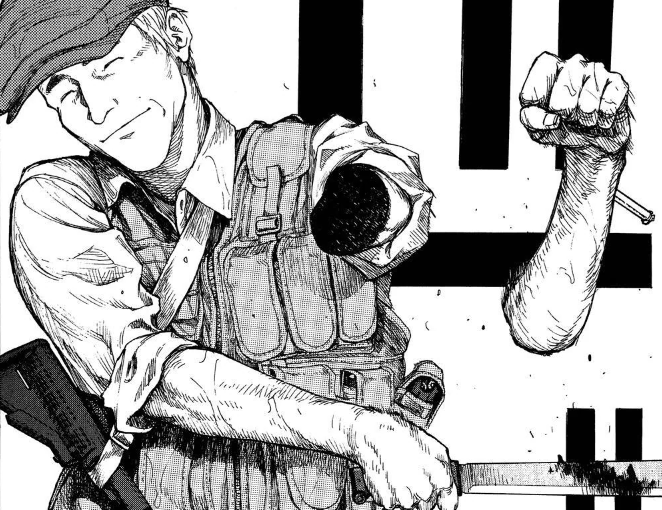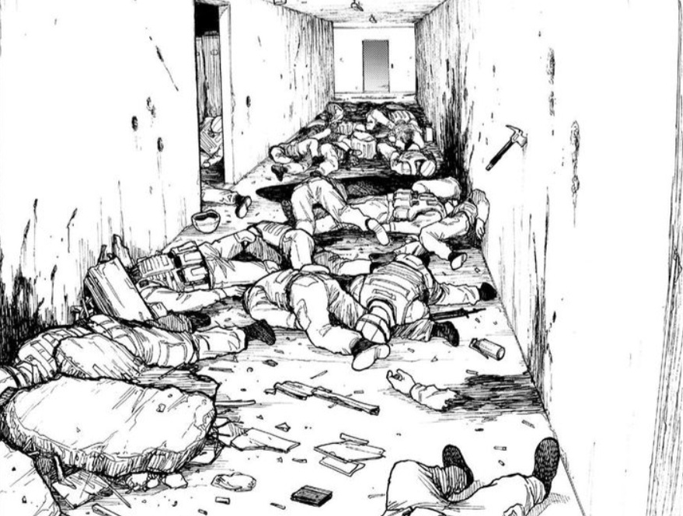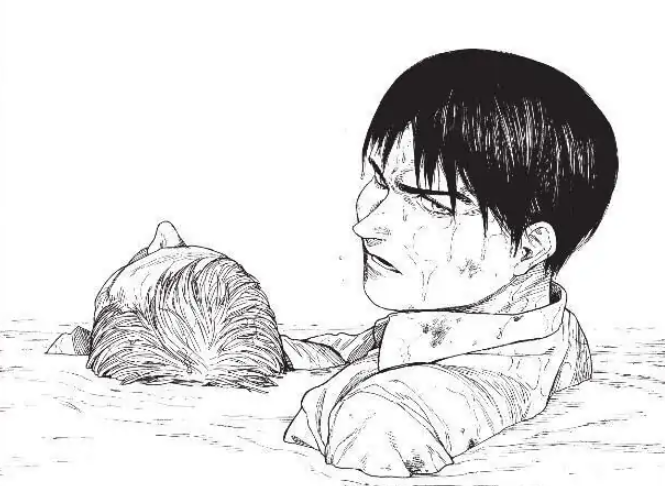Ajin: Demi-Human (manga review, spoilers)
It was a very frightening picture on Instagram that introduced me to this story. An elderly man with wispy hair smiled serenely as he emerged from a cyclone of black flesh and bone. Whilst the character was new to me, hundreds of comments praised the absolute terror of “Sato” the main antagonist of Ajin: Demi Human, by Gamon Sakurai. I would soon come to view him as one of the most charismatic villains I have ever read in a series. What’s interesting about Ajin is the diverse morality found among the cast: they are not all heroes, especially our main character, Kei Nagai, but they are compelled by their own sense of justice, and all have understandable and realistic motives. Likewise, Sato and his followers are driven by very personal intense desires.
Demi-humans/Ajin are humans that cannot die, but this fact is only known after they suffer apparent fatal incidents, at which point they “reset”, or revive. Once a demi-human is discovered, they are imprisoned by the Japanese government and subjected to torturous experiments, a practise that is hidden from the wider public. Kei, a cool high school prodigy with an attitude problem, gets knocked over and killed outside the school gates. After his death, he is surrounded by a black miasma and resurrected, much to everyone's shock and horror, including his own. Phones are whipped out of pockets and neighbours are called: a demi-human has been spotted—time for a hefty monetary reward from the authorities, and an indefinite sojourn for Kei. He goes on the run immediately, and is aided by his old childhood friend, Kaito.
Despite Kaito’s sacrifices to help Kei survive as a fugitive, Kei abandons him to live alone and is eventually arrested. His detainment catches the attention of Sato, an enigmatic and skilled demi-human with a hidden vendetta. Sato and his accomplice Tanaka storm into the facility to free Kei. He emerges from his confines a cold, stoic creature, but whilst he’s initially intrigued by Sato’s brutal rescue operation, something about the older Demi worries him, and in true Kei fashion, he goes his own way. Thus begins a complex, bloody, exhilarating cat-and-mouse conflict between Kei and Sato that doesn’t end until the penultimate chapter of the manga. This is a battle between two calculating geniuses, both possessing powers beyond human reason, both contending with their own hubris and the collateral world around them. A wider cast of characters, whilst enjoying some wonderfully profound moments, pale in comparison to these two protagonists. Kei and Sato are dynamite personified, seemingly only a few seconds away from detonation during every encounter.
Initially, Ajin reminded me of Tokyo Ghoul: A nerdy young male becomes a member of a highly persecuted non-human race and is thrust into a violent political battle for his own survival. He is helped by his altruistic childhood friend and contends with the realities of what it means to be truly human. But the similarities stop there. Whereas Ken Kaneki is unassuming, affable, and selfless, Kei Nagai is arrogant, self-centred, and indifferent to the suffering of others—initially, at least.
Kei is a brilliant character. It is easy to say that his indifference is just a cover for his soft interior, but it’s more complicated than that. He watched his father’s demise as a result of unconditional kindness and decided selfishness is the only way to survive in an unkind world. His mother tells him to stop hanging around with Kaito and he does, an action that seems cruel at first, but he is motivated by a desire to study hard, become a doctor, and cure his younger sister. He assuages his guilt by being openly hostile to Kaito in school. During his time as a fugitive, he takes extreme measures to survive, like imprisoning the hopelessly naive Nakano, and allowing hundreds, if not thousands, of innocent bystanders to die by Sato’s hand just so he can perfectly time his own counterattack. But Kei finds a moral counterweight in Nakano, and this encounter changes him.
Nakano is a demi-human that does not have an IBM: this is an almost indestructible entity that a demi-human can call at will. IBMs fight to protect their demi-human hosts and are vicious fighters. Despite being weak, and a little stupid, Nakano’s bold, uncomplicated will to do the right thing regularly disarms Kei. During a heated argument following their defeat to Sato, Kei attempts to sever ties with Nakano for good, deciding to leave the whole battle behind and resume his quest for a peaceful life outside Japan. Despite Nakano’s pleas, Kei turns away. It is pouring with rain, and they are both upset. Kei puts up an impressive façade, but the next panel reveals a devastating visage, tears pooling at the corners of his eyes. He is defeated and in turmoil, and he knows Nakano is right, but his ego is too bruised to continue. When Kei re-joins the fight with his usual nonchalance, it’s both anticlimactic and extraordinary, more evidence that the callous prodigy from the start of the story is being dismantled.
Sato goes through several changes as well. He is sociopathic and sadistic and has a lust for violence, but he is not heartless. When Tanaka wants to spare a woman on their hitlist, Sato allows him to, and when both Tanaka and Okuyama go their separate ways, he bears no ill will. Sato only cares about himself, but he appears to respect the freedom of his companions. He possesses a lawless ideology that is not hypocritical; he wants everyone to be as selfish as he is because it would make his own life fun. As Sato descends further into cruelty, Tanaka regains a sense of honour. He feels indebted because Sato freed him when he was imprisoned by the government, but whereas Sato just wants a fun time, Tanaka is truly fighting for demi-human rights. He wants change, and he soon realises that his ideology cannot coexist with Sato’s. He constantly wages a battle of morality within himself, joining team Kei begrudgingly, but when it comes time to deal a mortal blow to Sato and save the day, he falters and lets him go, still unable to betray the man who gave him freedom.
Some of Sato’s extreme behaviours include hijacking a commercial plane and flying it head-first into enemy headquarters, feeding himself into a woodchipper to re-materialise inside a heavily-fortified building, and severing his arm multiple times so he can repeatedly reset and fly fighter jets into civilian targets. For Sato, life is a game. He was bribed with Japanese consoles to enter a life of crime. After his rebirth as a demi-human, he could fulfil his fantasies in the real-world, dying and reviving, restarting the level, devising outlandish ways to overcome the boss. This is all seen in his gruesome fighting style. He carelessly shoots himself in the head, smiling all the while, and resets to immediately resume killing again. The last three volumes of Ajin are extraordinary, with thrilling tension that only increases with each chapter, and it is all because of Sato, his barbarism and ingenuity, how it all just feels so hopeless and impossible to defeat someone who has mastered absolute amoralism.
Sato sees a kindred spirit in Kei, which is why he grows more unhinged with each new phase of his attack against Japan. When he is finally about to leave Kei and Japan behind, he stops himself, because he realises that, during a moment of temporary amnesia, Kei killed himself just so he could remember Sato again and continue their fight. Sato is all at once touched, surprised, and impressed by Kei’s tenacity, and his desire for bloodshed is rekindled.
Through the course of the story, Kei exemplifies the resilience of the human heart; he perseveres, fighting against sense and his own wariness, because he wants to survive, and he wants to defeat Sato. He embodies the very human reality of being an “Ajin”.
Kei’s metamorphosis mirrors the theories of famed scientist Ikuya Ogura. During two wonderful chapters towards the end of the story, he discusses the nature of the human heart, how its natural attachment to life, to a goal, a loved one, a purpose, ruptures the natural fabric of our world and turns against nature itself. That will, and those emotions, stirred and blended at a precise moment, creates the demi-human. Demi-humans encapsulate the nonsensical nature of humanity, that innate obsession with survival. And on the very next page following this speech, is Kei Nagai, clinging onto the ankle of his adversary just as he’s about to make a dispassionate exit. Kei is fighting against nature, fighting against himself and the cynical voice within, because he needs to conquer Sato, he needs to win.
Alongside Kei and Sato is the principled Tosaki, whose noble efforts garner the respect of human and demi-human alike. His final act of exposing the demi-human experiments to the world, and keeping his promise to provide all his demi-human allies with new identities, is a touching and fitting end to a life of pain and tragedy. There’s also Gen, one of Sato’s accomplices, whose shock reveal as a human leads to a surprisingly devastating death. There’s also team Hirasawa, a group of lethal mercenaries who mostly experience bloody, yet badass, exits from the story.
Finally, the aforementioned Kaito: loyal to a fault, always stepping in to help others even to his own detriment. Kei is the first person to try to protect him, the first “friend” to put themselves in the line of danger so he doesn’t have to. Kaito’s kindness inspires his fellow juvenile inmate Takeshi, a demi-human in hiding, to free him, and he steps in to save Kei one last time. His death triggers Kei’s flood of IBMs. These IBMs are vengeful and distressed, and are of a volume not seen in any other demi-human before. The flood reflects the intense emotions that Kei has hidden so deeply in his heart, and it is significant that this flood of despair arrived for Kaito, the friend that he previously abandoned. When Kaito is revived, he chooses to live for himself. His new life is a gift, wrapped tightly in a parting warning given to him by Kei. At last, Kaito can be selfish.
Kaito’s altruism means he never expresses how much his friends have hurt him. In contrast, Nakano is open with his feelings, and his glaring honesty disarms Kei many times. Nakano likely fertilised the ground in Kei’s heart that led to his flood in the first place: if he was not so severely challenged by Nakano, he may not have had such an emotional outburst to Kaito’s death. Kaito’s behaviour is both noble and problematic; it's great that he's so dependable, but harsh truths are important for character growth.
There are some things in the story I would have liked to see developed more. From the very start, scientists and laypeople discuss the unusual “voice” that Ajin possess. Demi-humans have the ability to paralyse others with a certain scream. I assumed this power was going to have some significance considering those early pages, but it is only shown briefly.
Secondly, the anti-Demi military force is exceptionally capable. When they are finally called upon, they manage to defeat Sato’s accomplices within moments and heavily stall his plans. Considering their power, I found it strange that the government was so scared to deploy them sooner. Their fear of the force being seen by the wider public doesn't compare to the scale of civilian losses, so their constant delays only exacerbated the death toll.
Lastly, Kei’s random bout of amnesia at such a crucial time in the story made me groan out loud. I hate amnesia tropes, but this one seemed especially egregious with everything going on. It is saved by Kei shooting himself to regain his memories, because that very action of resetting triggers the only fatal error made by Sato. So whilst I was initially annoyed by Kei’s memory loss, I now appreciate Sakurai’s twist on the trope.
It is human resilience that wins in the end. In a flashback recounting a crucial conversation between Kei and Nakano, Kei asserts very simply that demi-humans are “regular people who cannot die”, not monsters or superheroes. Therefore, a demi-human can drown and be rendered unconscious, which would prevent resetting. Sato, having delayed his escape for one last, exciting fight, is then hurled into the water by Kei and forced into a coma. Sato is a fighting machine, and no other demi-human in the story utilises the advantage of being able to reset, to call upon a supernatural spirit, so expertly. The Ajin that embraced the core essence of human determination prevailed against the one who cloaked himself in his abnormality. Sato’s overconfidence in his Ajin powers blindsided him against mundane pitfalls. That panel of Kei cradling an unconscious Sato to his chest, with Sato looking so old and frail and human, is startling. It is an inconsequential end for someone who plagued the story with so much terror. In Kei, Sato was expecting a soulless sparring partner, but instead he found his moral superior.
I’ll give this a 9/10 (one point docked for the issues mentioned above).
This is a series you need to re-read. It is filled with poignant themes, brilliant foreshadow, and wonderful metaphors told in the actions of the protagonists. If you are looking for a new seinen read and enjoy violently chaotic villains, look no further than Ajin.









